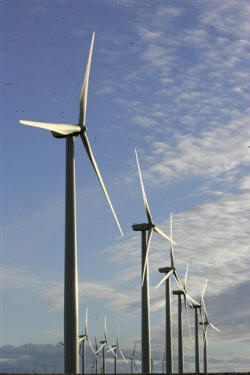|
 Use of wind energy expected to grow dramatically Use of wind energy expected to grow dramatically
 Send a link to a friend
Send a link to a friend
[May 13, 2008]
WASHINGTON (AP) -- Two decades from now Americans could get as much electricity from windmills as from nuclear power plants, according to a government report that lays out a possible plan for wind energy growth.
The report, a collaboration between the Energy Department research labs and industry, concludes wind energy could generate 20 percent of the nation's electricity by 2030, about the same share now produced by nuclear reactors.
Such growth would pose a number of major challenges, but is achievable without the need of major new technological breakthroughs, said the report released Monday.
|
|
 "The report indicates that we can do this nationally for less than half a cent per kilowatt hour if we have the vision," said Andrew Karsner, the Energy Department's assistant secretary for efficiency and renewable energy. "The report indicates that we can do this nationally for less than half a cent per kilowatt hour if we have the vision," said Andrew Karsner, the Energy Department's assistant secretary for efficiency and renewable energy.
If achieved, it would be an astounding leap.
Wind energy today accounts for only about 1 percent of the nation's electricity, although the industry has been on a growth binge with a 45 percent jump in production last year.
To reach the 20 percent production level, wind turbines would have to produce 300,000 megawatts of power, compared to about 16,000 megawatts generated today. Such growth would envision more than 75,000 new wind turbines, many of them larger than those operating today. About 54,000 megawatts would be produced by turbines in offshore waters.

And it would require a major expansion of the electricity grid system to move power from high-wind areas to other parts of the country, the report said.
"The United States possesses abundant wind resources," said the report spearheaded by DOE's National Renewable Technology Laboratory in Golden, Colo., and a 20 percent share of electricity production "while ambitious, could be feasible."

But the report cautioned that its findings were not meant to predict that such growth would, in fact, be achieved, but only that it is technically possible. And it acknowledged "there are significant costs, challenges and impacts" associated with such rapid growth.
It would require improved turbine technology, "significant changes" and expansion of power line systems and a major expansion of markets for wind energy to accommodate an annual growth rate of 16,000 megawatts of electricity a year beginning in 2018, more than five times today's annual growth.
[to top of second column] |
 Randall Swisher, executive director of the American Wind Energy Association, said the report confirms that wind energy "is no longer a niche" in the power industry.
Dan Arvizu, director of the department's National Renewable Energy Laboratory, said that the 18-month study provides a "vision" of the kind of wind energy growth technically possible.
"First of all, it's doable, second of all it's desirable," said Arvizu at a news conference.
"It's time for America to change the way we think about wind power," said Bob Lukefahr of BP Alternative Energy North America. The oil company is a leading wind developer, said Lukefahr.
If wind energy's share of power production grows to 20 percent, natural gas consumption is expected to decline by 11 percent and coal consumption by 18 percent in 2030, said the report. As a result carbon dioxide emissions linked to global warming would be reduced by 825 million metric tons a year.
"This is the equivalent of taking 140 million cars off the road," said Swisher.
___
On the Net:
Department of Energy: http://www.doe.gov/
[Associated
Press; By H. JOSEF HEBERT]
Copyright 2008 The Associated
Press. All rights reserved. This material may not be published,
broadcast, rewritten or redistributed.
 |